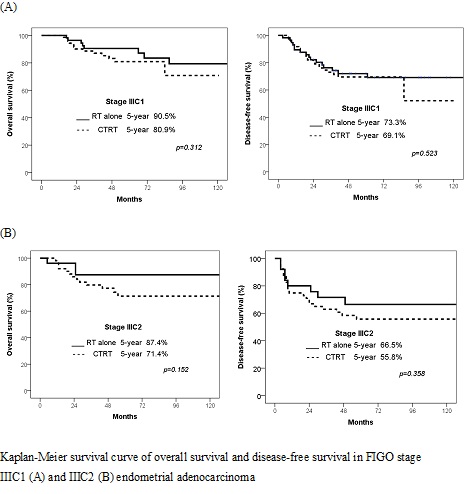글로벌 연구동향
방사선종양학
- 2015년 08월호
A multicenter analysis of adjuvant therapy after surgery for stage IIIC endometrial adenocarcinoma: A Korean Radiation Oncology Group study (KROG 13-17).(성균관의대/윤미선, 박원*)
- 출처
- Gynecol Oncol
- 등재일
- 2015 Jun 24
- 저널이슈번호
- pii: S0090-8258(15)30049-4.
- 내용

[Abstract]OBJECTIVE:
To investigate whether combined chemoradiotherapy (CTRT) confers a benefit for survival outcome over radiotherapy (RT) alone after primary surgery in patients with FIGO stage IIIC endometrial adenocarcinoma.
METHODS:
We conducted a multicenter retrospective study of patients with surgical stage IIIC endometrial cancer from 1990 to 2011. Adjuvant RT alone was performed in 85 patients (40.3%) and adjuvant CTRT in 126 patients (59.7%). Disease-free survival (DFS) and overall survival (OS) were analyzed using Kaplan-Meier method and Cox proportional hazards model.
RESULTS:
Stage IIIC1 and stage IIIC2 accounted for 63% and 37%, respectively. FIGO IIIC2 had a higher recurrence rate than FIGO IIIC1 (38.5% vs. 29.3%, p=0.172). Five-year OS and DFS were lower in FIGO IIIC2 than FIGO IIIC1 (85.1% vs. 76.9%, p=0.417; 71.0% vs. 59.2%, p=0.108, respectively). Eighteen patients (13.5%) in stage IIIC1 developed PALN recurrence, whereas only one (3.3%) in stage IIIC2 had PALN recurrence (p=0.001). In multivariate analysis, predictors of DFS were parametrial invasion (HR, 3.49; 95% CI, 1.83-6.64; p<0.001), higher grade (HR, 2.78; 95% CI, 1.31-5.89; p=0.008), and >3 positive pelvic nodes (HR, 1.84; 95% CI, 1.11-3.05; p=0.019). Combined CTRT did not affect DFS or OS in IIIC1 and IIIC2 compared with RT alone.
CONCLUSION:
CTRT showed comparable survival outcome to RT alone. Half of relapses (46%) in stage IIIC1 occurred in PALN region, whereas relapse in stage IIIC2 primarily occurred in distant metastasis (90%). Future randomized studies are needed to determine which subgroup may be most likely to benefit from CCRT.
[Author information]
Yoon MS1, Park W2, Huh SJ3, Kim HJ4, Kim YS5, Kim YB6, Kim JY7, Lee JH8, Kim HJ9, Cha J10, Kim JH11, Kim J12, Yoon WS13, Choi JH14, Chun M15, Choi Y16, Chang SK17, Lee KK18, Kim M19.
1Department of Radiation Oncology, Chonnam National University Hwasun Hospital, Chonnam National University Medical School, Jeollanam-do, Republic of Korea.
2Department of Radiation Oncology, Samsung Medical Center, Sungkyunkwan University School of Medicine, Seoul, Republic of Korea. Electronic address: wonro.park@samsung.com.
3Department of Radiation Oncology, Samsung Medical Center, Sungkyunkwan University School of Medicine, Seoul, Republic of Korea.
4Department of Radiation Oncology, Seoul National University Hospital, Seoul, Republic of Korea.
5Department of Radiation Oncology, Asan Medical Center, Seoul, Republic of Korea.
6Department of Radiation Oncology, Yonsei University College of Medicine, Seoul, Republic of Korea.
7Center for Uterine Cancer, Research Institute and Hospital, National Cancer Center, Goyang, Republic of Korea.
8Department of Radiation Oncology, St. Vincent's Hospital, The Catholic University of Korea, College of Medicine, Suwon, Republic of Korea.
9Department of Radiation Oncology, Inha University School of Medicine, Incheon, Republic of Korea.
10Department of Radiation Oncology, Yonsei University Wonju College of Medicine, Wonju, Republic of Korea.
11Department of Radiation Oncology, Dongsan Medical Center, Keimyung University School of Medicine, Daegu, Republic of Korea.
12Department of Radiation Oncology, Cheil General Hospital and Women's Healthcare Center, Kwandong University, College of Medicine, Seoul, Republic of Korea.
13Department of Radiation Oncology, Korea University College of Medicine, Seoul, Republic of Korea.
14Department of Radiation Oncology, Chung-Ang University Hospital, Seoul, Republic of Korea.
15Department of Radiation Oncology, Ajou University School of Medicine, Suwon, Republic of Korea.
16Department of Radiation Oncology, Dong-A University School of Medicine, Busan, Republic of Korea.
17Department of Radiation Oncology, CHA Bundang Medical Center, CHA University, Seongnam, Republic of Korea.
18Department of Radiation Oncology, University of Wonkwang School of Medicine, Iksan, Republic of Korea.
19Department of Radiation Oncology, Incheon St. Marys Hospital, The Catholic University of Korea, Incheon, Republic of Korea.
- 연구소개
- 대한방사선종양학회 연구위원회 부인암분과에서 후향적으로 병기 3 자궁내막암 환자에서 방사선치를 시행한 환자 데이터를 정리하여 분석하였다. 병기 3 자궁내막암에서 수술 후 적절한 추가 요법에 대해서는 아직까지 논란이 있다. 표준 치료법이 정해지지 않아 수술 후 항암화학요법 단독, 방사선치료 단독, 동시 혹은 순차적 항암화학방사선요법 등 추가 치료는 임상의의 판단에 따라 좌우된다. 연구는 전국에서 18개병원에서 정리해 준 450명의 환자데이터를 분석할 수 있었다. 본 논문은 병기 3 자궁내막암 중 병기 3C만을 분석한 것이고, 병기 3A 및 papillary serous와 clear cell carcinoma는 따로 분석하여 보고 예정이다. 논문은 자궁내막암 수술 후 방사선치료 단독과 항암화화방사선요법의 치료 결과를 분석한 것으로 기존 논문들에 비해 많은 수의 환자를 분석하였고, 후향적 분석이지만 비교적 두 치료군간 환자 특성이 비슷한 장점을 가지고 있다. 전체환자들의 5년 무병생존율은 66%, 전체 생존율은 82%로 높았고, 추가 방사선치료 단독이 추가 항암화학방사선요법에 비해 재발 양상은 달랐지만 무병생존율과 전체생존율에서 차이를 보이지 않았다. 그러나, 본 논문만 가지고 병기3C 자궁내막암에서 추가 방사선치료 단독이 충분하다고 할 수 없는데, 이는 추적관찰 중 원격전이가 전체 환자의 22%에서 발생함으로써 방사선치료만으론 부족함이 있다고 생각된다. 향후 추가 항암화학요법의 효과를 밝히기 위해서는 전향적 연구가 필요할 것이다
- 덧글달기







